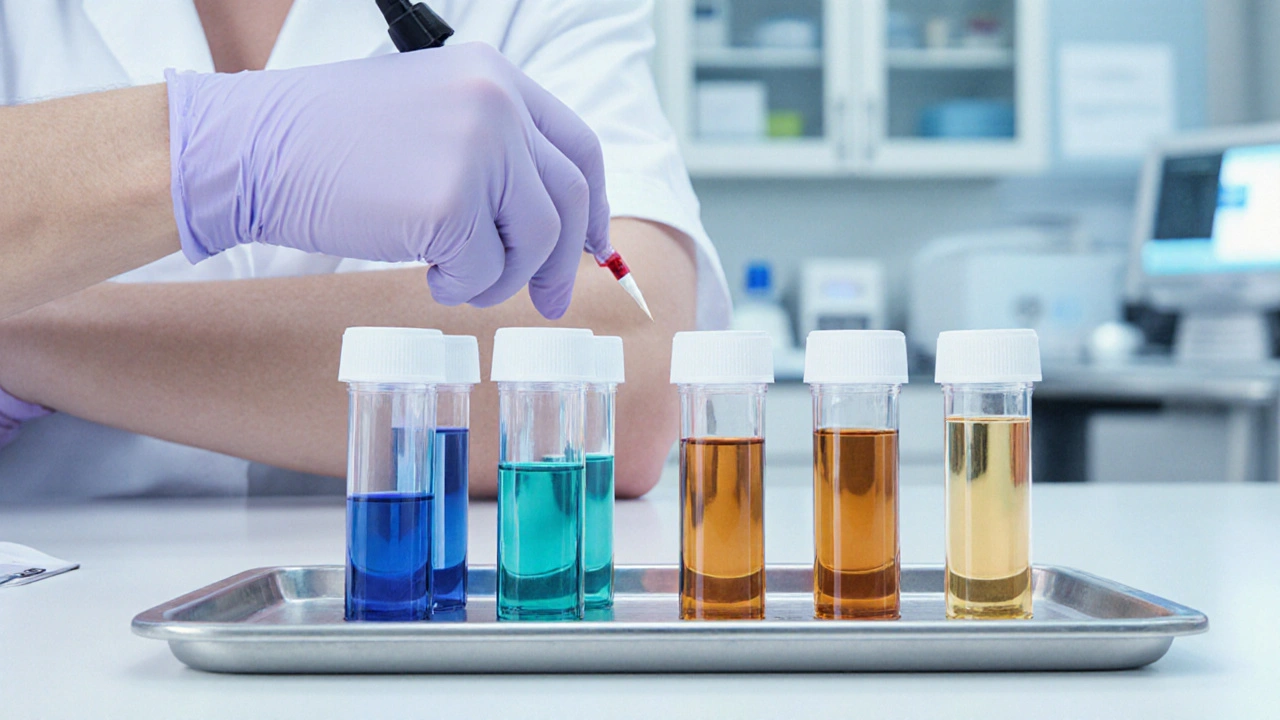Vitamin Deficiency Symptom Checker
Click on symptoms you're experiencing to identify potential vitamin deficiencies.
Based on your symptoms, your doctor may recommend these vitamin deficiency tests:
Feeling unusually tired, getting frequent colds, or noticing hair loss? Those could be clues that your body’s running low on a vital nutrient. Pinpointing a vitamin deficiency is a condition where the body lacks essential vitamins needed for normal metabolism, immunity, and growth. The good news? Modern labs can tell you exactly which vitamin is lagging, but you need to know which vitamin deficiency tests to order.
Symptoms that often trigger a check
Before you book an appointment, ask yourself if you’re dealing with any of these common signs:
- Persistent fatigue that doesn’t improve with rest
- Muscle cramps or bone pain
- Unexplained bruising or bleeding
- Changes in skin tone, dry patches, or hair thinning
- Difficulty concentrating or mood swings
These symptoms overlap across many deficiencies, so a targeted lab workup is the smartest next step.
What a basic blood workup looks like
The cornerstone of any deficiency workup is a blood test. Your doctor will usually start with a complete blood count (CBC), which gives a snapshot of red and white cells, hemoglobin, and platelet levels. Abnormalities here can hint at iron, B12, or folate problems.
From there, specific serum assays are ordered based on your history and the CBC results.
Vitamin‑specific tests you might need
Below are the most frequently requested assays, what they measure, and why they matter.
Vitamin D
The go‑to test is the serum 25‑hydroxy vitamin D. It reflects the vitamin D stored in your body. Levels below 20ng/mL usually signal deficiency, while 30‑50ng/mL is optimal for bone health.
Vitamin B12
Doctors measure serum vitamin B12. Values under 200pg/mL often correlate with neuropathy or anemia. If B12 looks borderline, a methylmalonic acid test can catch a functional shortage that the B12 assay misses.
Folate (VitaminB9)
Testing serum folate reveals recent dietary intake, while red blood cell folate reflects longer‑term stores. Low folate can cause macrocytic anemia and elevated homocysteine.
Iron
Iron status isn’t captured by a single number. A panel that includes serum ferritin, serum iron, total iron‑binding capacity (TIBC), and transferrin saturation paints the full picture. Ferritin under 30µg/L usually indicates depleted iron stores.
Vitamin A
Although rare in high‑income countries, a serum retinol test can confirm deficiency, especially in patients with malabsorption or severe liver disease.
Vitamin C
Plasma ascorbic acid is the standard assay. Levels below 0.2mg/dL signal scurvy‑risk, which can show up as gum bleeding or poor wound healing.

How to prep for your blood work
Getting accurate numbers often means a little preparation:
- Fasting: Most vitamin panels allow a regular breakfast, but the 25‑hydroxy vitamin D and iron tests are best done after an overnight fast (8‑12hours).
- Avoid supplements: Skip multivitamins and individual vitamin pills for 24hours prior, unless your doctor tells you otherwise.
- Medication check: Certain drugs-like proton‑pump inhibitors, metformin, or anticonvulsants-can skew B12 or folate levels. Bring a full medication list.
- Hydration: Drink water before the draw; dehydration can falsely elevate concentration results.
Most labs will notify you if a specific prep is needed for the test you’re having.
Reading the numbers - what’s normal?
Lab reports come with reference ranges, but “normal” can vary by age, gender, and even the assay manufacturer. Here’s a quick rule‑of‑thumb:
- Vitamin D: < 20ng/mL = deficient; 20‑30ng/mL = insufficient.
- Vitamin B12: < 200pg/mL = deficient; 200‑350pg/mL = borderline.
- Serum ferritin: < 30µg/L = low iron; 30‑100µg/L = adequate for most adults.
- Serum folate: < 3ng/mL = low; 3‑20ng/mL = adequate.
- Serum retinol: < 0.3µmol/L = deficient.
- Plasma vitamin C: < 0.2mg/dL = deficient.
If any value falls outside its range, discuss the cause with your GP. Sometimes a low number is temporary-think of a recent infection or a short‑term diet change-while other times it signals a chronic absorption issue.
Next steps after an abnormal result
Finding a deficiency isn’t the end; it’s a cue to act:
- Targeted supplementation: Choose a dose based on the severity. For vitamin D, 1,000‑2,000IU daily often corrects mild deficits within 8‑12 weeks.
- Dietary tweaks: Add oily fish, fortified dairy, leafy greens, or legumes depending on the missing vitamin.
- Follow‑up testing: Re‑check levels after 3‑6 months to confirm improvement. For B12 and iron, the timeline can be shorter-often 6‑8 weeks.
- Investigate underlying causes: Chronic gastritis, celiac disease, bariatric surgery, or certain medications can impair absorption. A gastro‑enterology referral may be warranted.
Most patients feel better within weeks of correcting a deficiency, but sustained monitoring ensures the issue doesn’t creep back.
Quick reference: Common vitamin deficiency tests
| Vitamin | Test Name | Sample Type | Typical Normal Range |
|---|---|---|---|
| Vitamin D | 25‑Hydroxy Vitamin D | Serum | 30‑50ng/mL |
| Vitamin B12 | Serum B12 | Serum | 200‑900pg/mL |
| Folate | Serum Folate | Serum | 3‑20ng/mL |
| Iron | Ferritin + Iron Panel | Serum | Ferritin 30‑300µg/L |
| Vitamin A | Serum Retinol | Serum | 0.3‑1.2µmol/L |
| Vitamin C | Plasma Ascorbic Acid | Plasma | 0.4‑2.0mg/dL |

Frequently Asked Questions
Which vitamin deficiency is most common in Australia?
Vitamin D deficiency tops the list, especially during winter months when sunlight exposure drops. Around 30‑40% of adults have levels below the optimal range.
Do I need to fast for a vitamin D test?
Fasting isn’t strictly required for 25‑hydroxy vitamin D, but many labs ask for an overnight fast to keep the protocol uniform when the test is bundled with iron studies.
Can supplements affect my test results?
Yes. High‑dose vitamin pills taken within 24‑48hours can artificially raise serum levels, masking a true deficiency. Pause supplements unless your doctor advises otherwise.
What does a low ferritin mean?
Ferritin stores iron. Low ferritin usually indicates depleted iron reserves, the earliest sign of iron deficiency before anemia appears.
If my B12 is borderline, should I get a methylmalonic acid test?
A methylmalonic acid test is the gold standard for functional B12 deficiency. It’s especially useful when serum B12 is in the 200‑350pg/mL range and you have neurological symptoms.
Bottom line: knowing which vitamin deficiency tests to order removes guesswork and gets you back to feeling your best faster. Talk to your doctor, get the right panels, and follow up on the results-your body will thank you.



Comments
Wow, this guide is exactly what I needed to finally get my labs in order! 🙌
Glad you’re pumped! When ordering the vitamin panels, ask your doctor to include both serum 25‑hydroxy D and a full iron panel in the same draw to save time. Also, request a methylmalonic acid test if your B12 hovers around 250 pg/mL, because it catches functional deficiencies early. Don’t forget to fast for at least eight hours before the iron and vitamin D assays; otherwise the results can be misleading. Finally, keep a copy of the reference ranges your lab uses, since “normal” varies by manufacturer.
Honestly, the whole fasting thing feels like a medieval ritual, but I’ve seen my iron numbers jump when I finally obeyed the empty‑stomach rule.
Yo! This article is lit 🔥 – super helpful for figuring out which tests actually matter. I’ve been skipping the B12 check for years, but after reading this I’m booking one tomorrow. Also, don’t forget to drink water before the draw, dehydration can mess with everything. Cheers!
Hey folks, great compilation! If you’re feeling that persistent fatigue, start with a CBC – it’ll point you toward iron or B12 issues right away. Should your CBC look fine, jump straight to a 25‑hydroxy vitamin D test; low D is a sneaky culprit for muscle aches. Remember, supplements can skew results, so pause them for a day unless your doctor says otherwise. And if you get abnormal numbers, schedule a follow‑up in 8‑12 weeks to track improvement. Keep a symptom journal; it helps the doctor see patterns you might overlook.
When we talk about vitamin deficiency testing, we are really delving into a fascinating intersection of biochemistry, epidemiology, and cultural nutrition practices that have evolved over centuries, and it’s worth taking a moment to appreciate that history. In many traditional societies, dietary deficiencies were identified not by a syringe but by observable patterns such as rickets in children or night blindness in adults, leading to early public health interventions. Modern medicine, however, has the advantage of precise serum assays that can quantify micronutrient levels down to nanograms per milliliter, providing an objective lens through which we can assess health. Yet, this precision comes with its own set of challenges, including variability between assay manufacturers and the influence of acute phase reactions on certain markers. For instance, ferritin is an acute‑phase reactant and can be artificially elevated during inflammation, potentially masking an underlying iron deficiency. Likewise, serum vitamin D concentrations can fluctuate with seasonal sun exposure, dietary intake, and even skin pigmentation, necessitating careful interpretation of results. It is also crucial to recognize that reference ranges are not one‑size‑fits‑all; they often differ by age, sex, geographic location, and even the laboratory’s specific calibration. Therefore, when you receive a result that sits on the borderline of “normal,” it is prudent to discuss the clinical context with your healthcare provider rather than taking the number at face value. In practice, I have found that coupling laboratory data with a thorough dietary history and symptom inventory yields the most accurate diagnosis. Moreover, the cost‑effectiveness of ordering a full vitamin panel versus targeted tests should be weighed against the pre‑test probability of deficiency, especially in resource‑limited settings. From a public health perspective, routine screening for vitamin D deficiency in populations at higher latitudes has been advocated, yet universal screening remains controversial due to mixed evidence on outcome improvement. On the other hand, specific at‑risk groups-such as individuals with malabsorption syndromes, bariatric surgery patients, or strict vegans-should be monitored more closely. When it comes to supplementation, the principle of “treat the deficiency, not the number” is paramount; over‑supplementation can lead to toxicity, as seen with hypervitaminosis A or D. Finally, remember that labs are tools, not verdicts; integrating laboratory findings with clinical judgment is the hallmark of good medicine, and keeping an open dialogue with your provider ensures that you receive personalized care that respects both the science and the lived experience of the patient. In summary, the journey from symptom to serum assay is nuanced, requiring attention to methodological detail, patient context, and the broader epidemiological landscape.
While the preceding exposition is certainly exhaustive, it overlooks the fundamental statistical considerations essential for interpreting assay variability. The coefficient of variation for serum 25‑hydroxy vitamin D, for instance, often exceeds 10 %, rendering marginal fluctuations clinically insignificant. A rigorous Bayesian approach would incorporate prior prevalence data, thereby refining post‑test probability beyond the simplistic “normal vs. abnormal” dichotomy presented. Moreover, the assertion that reference ranges differ by skin pigmentation lacks citation; contemporary studies indicate that such adjustments are minimal when standardization protocols are adhered to. Consequently, practitioners should prioritize assay precision and methodological transparency over anecdotal historical narratives.
Always double‑check if your lab uses ng/mL or nmol/L before comparing values.
i think the whole thing about vitamins is kinda like chasing shadows you look for a deficiency but maybe the body just cant talk the same way we do its like a silent movie where the colors are missing you understand that maybe we need more sunlight not just a lab test i guess
In many cultures, food sources naturally provide the micronutrients we test for, so the need for extensive panels varies widely. For example, traditional Mediterranean diets are rich in lutein and vitamin E, often reducing the prevalence of related deficiencies. When considering labs, it’s useful to weigh dietary patterns alongside genetic predispositions to tailor the most relevant tests.
Mayra, you’re glossing over the fact that assuming diet alone protects you ignores the prevalence of subclinical deficiencies even in so‑called “healthy” eating patterns. Studies show that up to 30 % of Mediterranean‑diet adherents still have low vitamin D levels due to limited sun exposure, and your blanket statement risks misinforming readers. It would be more responsible to highlight the need for periodic screening regardless of perceived dietary adequacy.
From a systems‑biology perspective, vitamin homeostasis represents a tightly regulated feedback loop wherein hepatic synthesis, renal reabsorption, and intestinal uptake converge to maintain serum concentrations within a narrow physiologic window. Perturbations in any node-be it due to malabsorption syndromes, pharmacologic interactions, or genotype‑dependent enzyme polymorphisms-can precipitate cascading metabolic derangements, manifesting clinically as fatigue, neurocognitive deficits, or hematologic anomalies. Therefore, a comprehensive assessment should integrate not only quantitative serum assays but also functional biomarkers such as methylmalonic acid for cobalamin status or homocysteine for folate and B12 interplay. Leveraging such multidimensional diagnostics enables clinicians to differentiate primary deficiencies from secondary compensatory mechanisms, ultimately guiding precision supplementation strategies.
Sure, let’s all run a dozen vitamin tests just because some Western website says “maybe you’re low.” In India we’ve thrived on turmeric and sunlight for centuries without a single 25‑hydroxy panel, but go ahead, pay for the lab and waste your money.
Love the thoroughness, but remember that a test is only as good as the conversation you have with your provider-no amount of lab jargon can replace a compassionate, patient‑centered dialogue. If you feel overwhelmed, ask for a plain‑language summary; it’s amazing how much clearer things become when the doctor swaps technical terms for everyday analogies.